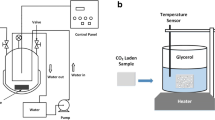Abstract
Compression testing of open cellular carbon foams is a challenge. The compression load between the foam specimen and the loading platen applies high stress concentration at the contact region and causing premature failure. Thus, the measured compression modulus and strength tend to be much lower than the real values of the foam. This paper presents a simple method to avoid or mitigate the stress concentration at the contact between the cell walls and the loading platen by end-potting of samples. The end-potting involves coating the top and bottom contact surfaces of the specimen by a thin layer of resin followed by curing. This offers a smooth contact between the specimen and two loading platens by potting the cell walls in resin thus reducing the contact stresses on the wall. Both the end-potted and standard (non-potted) specimens of low-density (CFoam20 and CFoam20G) and high-density (CFoam30 and CFoam30G) carbon foams were tested in compression. The standard specimens failed by crushing of edges of cell walls followed by progressive crushing of cells. The end-potting prevented local crushing of cells and failed suddenly in a shear failure mode like a brittle material. Compared to standard specimens, endpotted specimens resulted in higher modulus and strength of foams, produced consistent and reproducible test data. Thus, end-potting is recommended for compression testing of open-cell carbon foams and similar brittle foams.
Similar content being viewed by others
References
Moore, E.H., Carbon Foam Round Robin Test Method Development, AFRL-ML-WP-TR-2006-4118 (2005).
Bunning, T.J., Jeon, H.G., Roy, A.K., Kearns, K.M., Farmer, B.L., and Adams, W.W., “Polyurethane-Infiltrated Carbon Foams: A Coupling of Thermal and Mechanical Properties,” Journal of Applied Polymer Science 87: 2348–2355 (2003).
Klett, J.W., “High Thermal Conductivity, Mesophase Pitch-Derived Carbon Foams,” URL http://Physics.lbl.gov/~gilg/ATLASUpgradeRandD/HighKFoam/Graphite_Foams.pdf [accessed 25 May 2013].
Sihn, S., and Rice, B.P., “Sandwich Construction with Carbon Foam Core Materials,” Journal of Composite Materials 37: 1319–1336 (2003).
Mukhopadhyay, S.M., Pulikollu, R.V., and Ripberger, E., “Surface Modification of Graphitic Foam,” Journal of Applied Physics 93: 878–882 (2003).
Wang, X., Zhong, J., Wang, Y., and Yu, M., “A Study of the Properties of Carbon Foam Reinforced by clay,” Carbon 44: 1560–1564 (2006).
Chen, C., Kennel, E.B., Stiller, A.H., Stansberry, P.G., and Zondlo, J.W., “Carbon Foam Derived from Various Precursors,” Carbon 44: 1535–1543 (2006).
ASTM C365, Standard Test Method for Flatwise Compressive Properties of Sandwich Cores, Volume 15.03, ASTM International, West Conshohocken (1995).
Min, G., Zengmin, S., Weidong, C., and Hui, L., “Anisotropy of Mesophase Pitch-Derived Carbon Foams,” Carbon 45: 141–145 (2007).
Harte, A.M., Fleck, N.A., and Ashby, M.F., “Fatigue Failure of an Open Cell and a Closed Cell Aluminum Alloy Foam,” Acta Materialia 47: 2511–2524 (1999).
Kim, A., and Kim, I., “Effect of Specimen Aspect Ratio on Fatigue Life of Closed Cell Al-Si-Ca Alloy Foam,” Acta Mechanica Solida 21: 354–358 (2008).
Hakamada, M., Kuromura, T., Chino, Y., et al., “Monotonic and Cyclic Compressive Properties of Composite Materials Fabricated by Spacer Method,” Materials Science and Engineering A 459: 286–293 (2007).
Author information
Authors and Affiliations
Corresponding author
Rights and permissions
About this article
Cite this article
Gowthaman, S., Shivakumar, K. & Mathiyalagan, P. End-Potting Concept for Compression Testing of Open-Cell Carbon Foams. Exp Tech 40, 357–366 (2016). https://doi.org/10.1007/s40799-016-0039-3
Published:
Issue Date:
DOI: https://doi.org/10.1007/s40799-016-0039-3




